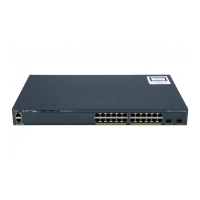12-20
Catalyst 2960 and 2960-S Switches Software Configuration Guide, Release 15.0(1)SE
OL-26520-01
Chapter 12 Configuring Interface Characteristics
Using Interface Configuration Mode
Configuring a Range of Interfaces
You can use the interface range global configuration command to configure multiple interfaces with the
same configuration parameters. When you enter the interface-range configuration mode, all command
parameters that you enter are attributed to all interfaces within that range until you exit this mode.
Beginning in privileged EXEC mode, follow these steps to configure a range of interfaces with the
same parameters:
When using the interface range global configuration command, note these guidelines:
• Valid entries for port-range, depending on port types on the switch:
–
vlan vlan-ID, where the VLAN ID is 1 to 4094
Note Although the command-line interface shows options to set multiple VLANs, these
options are not supported on Catalyst 2960 and 2960-S switches.
–
gigabitethernet stack member/module/{first port} - {last port}, where the module is always 0
–
fastethernet module/{first port} - {last port}, where the module is always 0
–
gigabitethernet module/{first port} - {last port}, where the module is always 0
–
port-channel port-channel-number - port-channel-number, where the port-channel-number
is 1 to 6
Note When you use the interface range command with port channels, the first and last
port-channel number must be active port channels.
Command Purpose
Step 1
configure terminal Enter global configuration mode.
Step 2
interface range {port-range | macro
macro_name}
Specify the range of interfaces (VLANs or physical ports) to be
configured, and enter interface-range configuration mode.
• You can use the interface range command to configure up to five
port ranges or a previously defined macro.
• The macro variable is explained in the “Configuring and Using
Interface Range Macros” section on page 12-21.
• In a comma-separated port-range, you must enter the interface
type for each entry and enter spaces before and after the comma.
• In a hyphen-separated port-range, you do not need to re-enter the
interface type, but you must enter a space before the hyphen.
Step 3
Use the normal configuration commands to apply the configuration
parameters to all interfaces in the range. Each command is executed
as it is entered.
Step 4
end Return to privileged EXEC mode.
Step 5
show interfaces [interface-id] Verify the configuration of the interfaces in the range.
Step 6
copy running-config startup-config (Optional) Save your entries in the configuration file.

